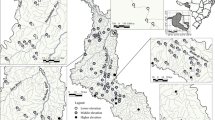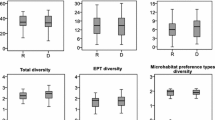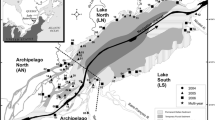Abstract
In most soft-bottomed, lowland streams in the Netherlands discharge regimes largely follow the precipitation pattern. Winter discharges are higher and much more dynamic then summer discharges, although rain storms throughout the year cause unexpected peak flows. Minimal precipitation, reduced stream flow and droughts can occur during the summer months. Lowland stream habitat, particularly in The Netherlands, is hydrologically dynamic, with substrates frequently moved or disturbed. Differences in discharge patterns in Dutch soft-bottomed lowland streams are expected to affect distribution patterns of macroinvertebrates and thus oligochaetes. Ten small to medium sized lowland streams, differing from one another in hydrological regime, were studied. Five major habitats in each stream were assessed on three occasions over a 15-month period. Each habitat sampled with a micro-macrofauna shovel; during each sampling period, several environmental parameters, especially hydrological and substrate parameters, were measured. Ordination (CANOCO) (Ter Braak, 1989) and statistical tests (chi-squared test) (Lindgren & McElrath, 1970) were used to determine the major oligochaete distribution patterns between streams as well as between habitats within each stream. Each stream was characterized by its oligochaete assemblage; general distribution patterns and individual oligochaete–substratum relationships were documented. Hydro-morphological parameters together explained the differences in major distribution patterns. Preferences of oligochaetes for specific structural habitats are discussed.
Similar content being viewed by others
References
Boon, P. J., 1998. River restoration in five dimensions. Aquatic Conservation: Marine and Freshwat. Ecosystems 8: 257–264.
Brinkhurst, R. O., 1964. Observations on the biology of lake dwelling Tubificidae (Oligochaeta). Arch. Hydrobiol. 60: 385–418.
Brinkhurst, R. O., 1971. A guide for the identification of British aquatic Oligochaeta. Freshwat. Biol. Ass., Sc. Publ. 22.
Chekanovskaya, O. V., 1962. The aquatic oligochaete fauna of the U.S.S.R. Opred. Faune SSSR 78: 1–411.
Hildrew, A. G. & C. R. Townsend, 1977. The influence of substrate on the functional response of Plectrocnemia conspersa (Curtis) larvae (Trichoptera: Polycentropidae). Oecologia 31: 21–26.
Huston, M., 1979. A general hypothesis of species diversity. Am. Nat. 113: 81–101.
Laakso, M., 1969. Oligochaeta from brackish water near Tvärmine, south-west Finnland. Ann. zool. fenn. 6: 98–111.
Lindgren, B. W. & G. W. McElrath, 1970. Introduction to Probability and Statistics. MacMillan Comp., London (3rd edn.): 305 pp.
Minshall, G. W., 1988. Stream ecosystem theory: observed patterns and potential applications. J. n. am. Bentol. Soc. 7: 263–289.
Petersen, R. C., L. B. M. Petersen & J. Lacoursière, 1992. A building-block model for stream restoration. In Boon, P. J., Calow P. & G. E. Petts (eds), River Conservation and Management. John Wiley & Sons, Chichester: 293–310
Särkkä, J., 1987. The occurrence of oligochaetes in lake chains receiving pulp mill waste and their relation to eutrophication on the trophic scale. Hydrobiologia 155: 259–266.
Schuster, R. W., 1915. Morphologische und Biologische studien an Naididen in Sachsen und Böhmen. Julius Klinkhardt, Leipzig.
Statzner, B., J. A. Gore & V. H. Resh, 1988. Hydraulic stream ecology: observed patterns and potential applications. J. n. am. Bentol. Soc. 7(4): 307–360.
Ter Braak, C. J. F., 1987. CANOCO-A FORTRAN program for canonical community ordination by [partial] [detrended] [canonical] correspondence analysis, principal component analysis and redundancy analysis (version 2.1). TNO Institute of Applied Computer Science, Wageningen, The Netherlands: 1–95.
Timm, T., 1970. On the fauna of the Estonian Oligochaeta. Pedobiol. 10: 52–78.
Tolkamp, H. H., 1980. Organism-substrate relationships in lowland streams. Agricultural Research Reports 907, Doctoral thesis, Wageningen: 211 pp.
Verdonschot, P. F. M., 1987. Aquatic oligochaetes in ditches. Hydrobiologia 155: 215–222.
Verdonschot, P. F. M., 1994. Water typology: a tool for water management and nature conservation. Verh. int. Ver. Limnol. 25: 1911–1913.
Verdonschot, P. F. M., J. M. C. Driessen, H. G. Mosterdijk & J. A. Schot, 1998. The 5-S-Model, an integrated approach for stream rehabilitation. In Hansen, H. O. & B. L. Madsen (eds), River Restoration’ 96, Session Lectures Proceedings. National Environmental Research Institute, Denmark: 36–44.
Author information
Authors and Affiliations
Rights and permissions
About this article
Cite this article
Verdonschot, P.F. Hydrology and substrates: determinants of oligochaete distribution in lowland streams (The Netherlands). Hydrobiologia 463, 249–262 (2001). https://doi.org/10.1023/A:1013132514610
Issue Date:
DOI: https://doi.org/10.1023/A:1013132514610




